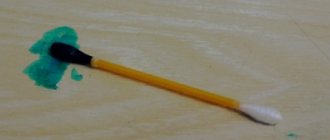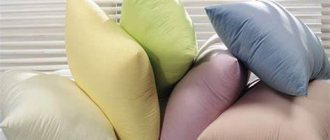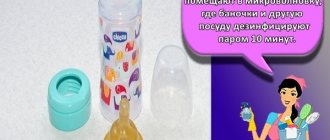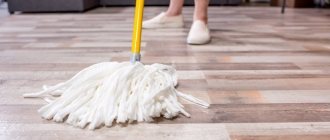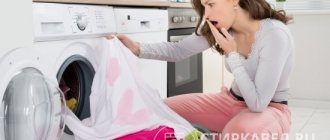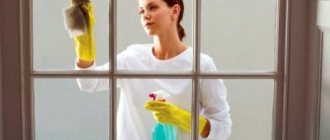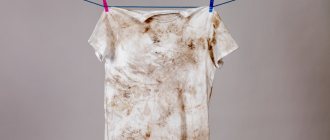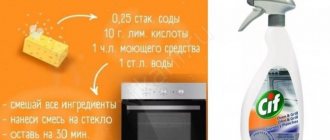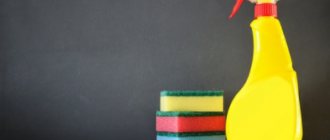/Order/
Despite the antistatic and protective impregnations of suspended ceilings, they still need to be washed. In living rooms, it is advisable to do this 1-2 times a year, and in the kitchen - every 2-3 months as greasy deposits and soot appear. Fortunately, cleaning ceilings is not so troublesome; cleaning does not require additional costs and does not take much time. In this material we will tell you how and with what to wash stretch ceilings (glossy, matte, satin and fabric).
Is it possible to wash suspended ceilings?
Canvases are made from two types of materials: PVC film and synthetic fabric, which differ in texture, properties and care characteristics.
Vinyl film, which tolerates moisture well, is more common. It is recommended for bathrooms and kitchens. PVC fabric is waterproof and can even hold water in the event of a flood. Subsequently, it is carefully drained and the ceiling takes on its previous appearance.
PVC film can be washed both with clean water and with household chemicals.
It is recommended to do wet cleaning periodically (1-2 times a year in living rooms and every 3 months in the kitchen). If stains from grease, paint or other contaminants have formed, it is better to remove them immediately before they dry.
Do not use products containing acetone, which dissolve the surface. Compositions with abrasive particles will not work either - the ceiling will be scratched and cannot be restored.
The second option is polyester fabric with reinforcing impregnation (for example, from Descor). The material is more durable, but tolerates water less well. Dry cleaning is recommended for this fabric. Wash only heavily soiled areas and very carefully.
Important! Before starting cleaning, remove all jewelry with sharp edges that can damage the film (bracelets, watches and especially rings). Also, do not use hard brushes or sponges with an abrasive layer for cleaning.
Method of washing fabric covering
The peculiarity of this interior element is that it does not tolerate a very wide range of cleaning agents. For example, some of the mentioned methods cannot be applied to it, in particular washing with glass solutions, which eat into the structure of the fabric, subsequently changing its color due to coloring additives. In addition, such a surface does not tolerate circular movements when wiped with a cloth. The result of careless handling is noticeable stains, and they are incredibly difficult to get rid of.
Experts advise using water with the addition of washing powder/ammonia/soap/dishing detergent, removing heavy dirt with direct movements. By the way, such a ceiling is not afraid of abrasives, and this is its advantage. You can also carefully vacuum it, getting rid of cobwebs, which is strictly prohibited in relation to film products.
How to wash glossy fabric without streaks
Stretch ceilings have antistatic properties, but some dust still settles on the surface. First you need to remove it with a soft cloth so as not to spread dirt. Materials such as microfiber and flannel do an excellent job and do not scratch the fabric.
Then wet cleaning begins. Use a sponge (only the soft side) or a rag to wipe the ceiling from one corner to the other. To avoid streaks, movements should not be circular, but back and forth. They act carefully, with minimal pressure.
For serious contamination, you will need specialized products for suspended ceilings, which are added to water or applied with a spray bottle. Then the solution is washed off. Below we will take a closer look at professional detergents, as well as suitable household chemicals.
In large rooms it is inconvenient to process the entire surface at once, so the canvas is divided into segments, cleaning towards the middle. The soldered film and multi-level structures are also removed in parts.
There are several ways to wash glossy stretch ceilings without streaks:
- after wet cleaning, wipe thoroughly with a dry cloth;
- use a special product - “Pronto anti-dust”;
- dilute 10% ammonia with water (in a ratio of 1:10) and treat the ceiling.
The gloss is narrower than other textures, which is why different fabrics are often soldered together. Stains are less noticeable if you wipe the ceiling along the seam rather than across it.
Advice! On dark gloss, scratches are especially noticeable. To avoid microdamage, use wet alcohol wipes when cleaning.
What to do with unusual stains and defects
If you clean your ceiling incorrectly, it may cause minor damage. Many of them can be dealt with independently, without replacing the finishing material.
Small wrinkled spots
After a flood, PVC film may wrinkle. This occurs due to stretching and especially from hot water. After a few hours, high-quality material levels out and takes on its original appearance.
If a day after a wrinkled spot from flooding appears on the suspended ceiling, the material has not been smoothed out, the surface is leveled using a heat gun.
When it is not possible to call a specialist with special equipment, they use a construction or regular household hair dryer. The canvas is heated with warm air, kept at a distance of about 30 cm from the ceiling. You should not bring the device closer - the PVC film may melt.
The appearance of small holes
It is not always possible to avoid damage to the ceiling during cleaning. Don't immediately panic about small holes or slits. You can try to repair the finish yourself. The nature of the repair depends on the material.
Damage to the fabric ceiling is painted over with acrylic paint of the appropriate color. A large hole is eliminated with a piece of the same fabric. Therefore, there is no need to throw away the scraps remaining after installation of the structure. You can also use glass wallpaper or thick fabric for a patch, which is glued to the canvas. The gluing area is carefully smoothed. If the required fabric is not found, take any other one, and then paint the ceiling in the desired color.
If small holes appear in a PVC stretch ceiling at a distance of 15 cm from the wall or closer, you can get rid of them completely. To do this, the material is pulled out from the profile. The punctured area is cut along the holey edge and the remaining film is glued to the harpoon. Then the canvas is heated with a construction hairdryer and stretched again. In other cases, a patch made from the same PVC film is glued on. It is better to install the patch from the inside - such a repair looks more aesthetically pleasing.
The adhesive for these jobs must be transparent, fast-acting and coating-friendly. These requirements meet:
- Cosmofen;
- SomaFix;
- Loctite;
- Cosmoplast.
Read more: How to repair a hole in a suspended ceiling
You can also disguise the damage by making a colored appliqué in its place. Ready-made compositions are sold in construction supermarkets. To prevent the masking element from being noticeable, stickers are attached in several places, creating a single composition or pattern.
Stains on the ceiling are not always removed, and it is often easier to prevent their appearance. For tension structures to last a long time, the room must be dry. Before installing the finishing, the condition of the pipes is checked, and good ventilation is installed in the bathroom. It is better not to smoke in the apartment, this will cause the coating to turn yellow. If there is no major contamination, then it is enough to wipe the fabric with a dry microfiber cloth once every 6 months.
How and with what to wash a matte ceiling
On a surface without shine, stains, splashes and dust are almost invisible. But the film is not completely smooth, so it is a little more difficult to clean.
The matte ceiling is also washed with smooth movements without pressure. Large canvases are divided into segments. Finally, wipe dry with a clean cloth.
Important! The water should be warm (from 23-25° to 35°C). Hot liquid (over 40°C) can damage the film.
No special anti-stain treatment is needed. Moreover, products containing ammonia or regular alcohol are not suitable for matte canvases.
The nuances of cleaning a satin ceiling
PVC film with this texture has a peculiar surface reminiscent of fabric. Light is reflected, but not as much as from gloss. It looks beautiful, but due to the uneven texture, dust and dirt accumulate faster. It is more difficult to clean such ceilings. But divorces are almost invisible.
When choosing products, they choose the same options as for gloss. This is a solution containing ammonia.
Reasons for contamination of glossy ceilings
Although the manufacturers promise that maintaining the structure will not be burdensome due to the impregnation of the canvas with a water- and dirt-repellent agent, after a while the owners of the apartment notice that the gloss does not shine as before, and dust is noticeable.
Little children can get creative and even be able to leave a mark from a felt-tip pen on the ceiling, splash juice or sweet tea on the ceiling. In the kitchen, the ceilings get dirty mainly due to the cooking process, even despite the presence of a working hood.
How to wash fabric stretch ceilings
Unlike PVC film, the fabric has a textured texture and micropores due to the interweaving of the threads, as a result of which it tolerates moisture less well and makes it more difficult to remove dirt from the surface. It is advisable to use dry cleaning. At home, dust removal is carried out with soft microfiber or flannel cloths.
If dirt appears, carefully apply soap suds to them or spray them with a solution for suspended ceilings from a spray bottle. It is advisable to only hit the stain. Wait 5 minutes for the composition to take effect, and then carefully rinse off.
5% soda ash cleans the ceiling well. The product is diluted, applied and left to dry. Then carefully rinse and wipe dry.
Also help deal with stains:
- alcohol (a small amount is applied to a cotton pad or swab and the stain is treated);
- hydrogen peroxide (use a sponge);
- foam cleaner for fabric car interiors.
If you are unable to remove the marks yourself, you can try contacting cleaning companies or fabric ceiling manufacturers.
And the last way is to paint the spot or the entire surface. The fabric can be painted several times with water-based compounds.
Read more: How to paint a suspended ceiling yourself
Some more advice on prevention and care
- If your kitchen has suspended ceilings, do not forget to use the hood every time you cook (especially if you have a gas stove!).
- Remember that it is better to wipe off any stains immediately before they dry out and become ingrained.
- To simply remove dust, just wipe the ceiling with a dry cloth.
- In difficult cases, it is better to use the services of a cleaning company or the services of a ceiling installation company (some companies provide cleaning services). Professionals clean tension structures with special vacuum cleaners and detergent compounds.
Support the project - share the material with your friends on social networks:
Professional detergents for suspended ceilings
There are many formulations available on the market. Let's list the most popular:
- “EdelWeiss” is available in the form of a spray with a spray bottle, so it is used sparingly. There is no need to wash off the composition: there are no streaks left. "Edelweiss" is a product containing alcohol, recommended for smooth and satin fabrics.
- "Nouvel" is another spray for cleaning suspended ceilings. Works great on old grease, insect stains and unpleasant odors. Thanks to its convenient shape, the bottle does not slip out of your hands.
- “Premier” is a stain removal spray that acts quickly (from 30 seconds to a minute) and does not damage the film.
- "Iron" - contains silver extract. This aerosol has an antibacterial effect, removes dust and dirt, and is effective against traces of nicotine, but does not cope so well with greasy stains.
- "Amelia" is another domestic drug. Available in a spray bottle and does not contain aggressive substances.
- "LOC" is a universal cleaning product from Amway. Suitable for all types of suspended ceilings due to its soft composition. It’s not a budget product, but it quickly cleans any surface and doesn’t leave streaks.
We protect the ceiling from stains!
any problem than to deal with the consequences later! The same goes for stains on a stretch ceiling. It is easier to prevent stains from appearing than to clean a suspended ceiling while standing on a stepladder. After all, all the factors listed above are quite predictable. There are several ways to avoid dirt on the ceiling:
- Clean regularly. During your weekly cleaning, run the vacuum cleaner over the ceiling without touching the surface with the brush. This way you will remove dust that has not yet become embedded in the canvas. Carry out wet cleaning regularly, preferably using a steam cleaner.
- Do not allow guests to smoke in living areas and do not smoke yourself! As a last resort, go smoke closer to the kitchen hood. And turn it on at full power!
- Yes, yes, the hood must be powerful! Don't forget to turn it on, even if you're just boiling a kettle or cooking porridge. Change the filters in your hood on time. Otherwise, greasy stains on the kitchen ceiling cannot be avoided.
- In the first warm days, install screens on the windows . It's not expensive at all! The nets will reliably protect living spaces from insects.
- If you're throwing a party at home, try to be careful ! Do not shake the champagne bottle or use pyrotechnics in the rooms.
Proven Home Remedies
Not only specialized compounds are suitable for suspended ceilings. Matte and fabric canvases are cleaned with soapy water. It is better to make it using laundry or tar soap. Liquid or toilet soap is also suitable, but only if it does not contain dyes. For gloss and satin, ammonia is added (in a 1:1 ratio).
Also use powder diluted in water for hand washing (without bleach). But you need to carefully dissolve all the granules so that the grains do not scratch the surface. Foam is applied to the ceiling, resulting from beating water and powder.
If the canvas has turned yellow after being flooded by neighbors, the traces are removed with diluted vinegar (6-9% diluted to a ratio of 1:9). Reddened areas are moistened with this product. Then rinse thoroughly, wipe dry and ventilate the room.
Old stains are removed by blotting with ammonia or regular alcohol (can be replaced with vodka). Apply the product to the stain, wait a few minutes and wipe with a soft cloth.
Unobvious helpers from ordinary household chemicals
Many housewives use improvised means to wash the suspended ceiling. But before use, it is better to test them on a small and inconspicuous area of the canvas.
Glass cleaner
Choose compositions based on ammonia, which are suitable for all types of suspended ceilings, except for fabric and matte film. The products cope with grease, soot and other types of stains. Sprays are easy to apply, evaporate quickly and clean the surface efficiently. It’s convenient that they don’t need to be washed off; just wipe them with a dry cloth (as when cleaning windows).
Important! It is better to choose liquids without dyes.
The following brands are used:
- "Mister Muscle";
- "Mister proper";
- "HG ECO International";
- and etc.
Dishwashing gel
The product is used to remove greasy deposits, including old ones. It is neutral in pH, like regular soap, but works more effectively. Gels are used to clean suspended ceilings in the kitchen. But compositions with abrasive particles (such as Pemolux) are not suitable; they can scratch the ceiling.
Add 2 teaspoons of Feri or another product to 5 liters of water and beat until a fluffy foam forms. It is applied to the ceiling, and after a while it is removed along with the dirt. Then the residues are removed with warm water. This method is suitable for all types of canvases.
Dry cleaning
Some types of suspended ceilings do not tolerate contact with water. For example, polyester fabric can only be cleaned dry.
In any case, dry cleaning precedes wet cleaning, and sometimes completely replaces it. The idea is to remove dust from the surface without allowing it to penetrate deeper into the fabric under the influence of water and friction. But correctly removing dust from a stretch ceiling is not as easy as it seems at first glance . There are a number of nuances when choosing tools and the wiping technique itself.
Vacuum cleaner
So, the first (but rather risky) way to clean a stretch ceiling is a vacuum cleaner.
What coatings are they used for?
A vacuum cleaner is used to clean fabric (and only fabric) suspended ceilings. Turn on the device in gentle mode, keep the nozzle at a distance of 3-5 cm from the canvas. First make sure that the ceiling is tightly fixed. Avoid connections to the frame and fastening of lighting fixtures.
What does it clean?
A vacuum cleaner helps get rid of settled dust and surface deposits. It also removes cobwebs easily.
For some types of suspended ceilings, a washing vacuum cleaner is suitable. It can only be used in cases where there are no stains on the ceiling. Set the power to minimum.
You can find videos online where suspended ceilings are cleaned using a steam cleaner , after placing a soft cloth on the nozzle. This is a very risky option , which is absolutely not suitable for PVC films. The steam temperature is high and can simply deform the beautiful coating. If you dare to work with a steam cleaner, try not to stay on one section of the ceiling for more than a few seconds so that the steam does not have time to damage the coating.
Another caveat: steam cleaners are usually quite heavy and bulky, so it’s not so easy to clean the ceiling with them accurately .
Conclusion: do not use a vacuum cleaner to clean PVC films (modern satin ceilings also include them) and poorly fixed suspended ceilings. In order not to overdo it with power, use a low-power handheld vacuum cleaner and always have a soft nozzle. It’s better to remove dust and cobwebs the “grandmother’s” way - using a soft, lint-free cloth.
Flannel napkins and rags
PVC films (including satin films, which are also made from PVC) cannot be vacuumed - this can lead to sagging. Use a slightly damp or dry flannel cloth and then buff until shiny with another clean cloth or rag. But do not overdo it with friction so as not to deform the surface.
What ceilings should I use it for?
Fabric and PVC ceilings can be cleaned with any clean and soft dry lint-free cloth (flannel, microfiber, suede, cotton, silk). Fabric ceilings should only be wiped with a dry cloth, while PVC ceilings should be wiped with a damp, well-wrung out cloth. For convenience, it can be pulled over a mop. Then wipe the ceiling from dust with smooth movements, starting from the corner and moving from one wall to another.
Thus, using a soft, lint-free cloth (sponge, napkin) you can clean all types of ceilings from dust. A dry rag is preferred for fabrics (especially polyester) and vinyl.
for matte ceilings .
Textile ceilings can also be cleaned with a soft bristle brush.
What are they cleaning?
Using dry or slightly damp lint-free rags, napkins and soft brushes it is convenient to remove dust, cobwebs, surface dirt, and various microparticles of debris .
A few words need to be said about the direction of movement :
- When cleaning the fabric, do not use circular movements. Move your hand back and forth, trying not to stay in one place for too long.
- To clean all other types of ceilings, on the contrary, it is effective to use circular movements.
Eraser
Using an eraser, you can remove newly formed stains that require no effort to remove. Just take a soft, perfectly clean rubber band. Wipe off the eraser pellets with a damp cloth.
If dry cleaning seems ineffective, move on to the next step.
What can be added to washing the ceiling?
Manual cleaning is not always convenient. This method takes a lot of time, and you also have to constantly climb onto a stepladder. Household appliances can make work easier.
Steam cleaner
Can only be used for film materials that are resistant to moisture. The device is set to the minimum temperature and kept at a short distance from the ceiling. Using a steam generator, you can not only do regular wet cleaning, but also “soak” old stains, which are then easier to remove.
Vacuum cleaner
It is used for dry cleaning. Choose a soft brush. You need to act very carefully, without pressure, so as not to damage the ceiling with strong pressure. But vacuuming is much faster than wiping with a rag.
Important! Washable models cannot be used! They don't act delicately enough.
Window mop
It is best to clean the ceiling from a stepladder with a rag, but this is not always convenient. It is permissible to use a telescopic mop with microfiber if the distance to the subfloor is more than 5 cm (otherwise the cloth will be pressed through and may be damaged by the unevenness of the base ceiling).
Lifehacks of a cleaning specialist
- If you are washing the ceiling for the first time or trying out a new product, start with inconspicuous areas , for example, corners. Apply the product, wipe with a damp and dry cloth, and check after 10 minutes. If the washed area has not faded, faded, deformed and there are no streaks left on it, the product is suitable.
- Move from the walls to the center of the canvas.
- Clean cracks and seams , not across.
- Using circular movements makes it easier to clean a glossy ceiling until it shines.
- Do not use a mop or other improvised means with a long handle - it will be difficult for you to control your efforts, which can lead to damage to the cloth.
- If you use a mop , then choose one with a movable platform and a flat microfiber head. Make sure there are no nicks or sharp corners. Operate the tool while standing on a stepladder to better regulate the pressure on the ceiling.
- If the stretch ceiling is located close to the base (at a distance of 3-4 cm), it is washed only by hand from a stepladder, trying to apply minimal pressure.
- Remember to remove watches, bracelets and rings before cleaning to avoid accidentally damaging the suspended ceiling.
- After cleaning and drying the matte/glossy ceiling, it can be treated with an antistatic agent to prevent the adhesion of dust particles (this should be done no more than once a year). You will notice that the next time you clean, the ceiling will be much easier to clean.
- If, despite your efforts the stains on the ceiling do not disappear , there is no need to try to rub harder or use aggressive products. This way you will simply ruin an expensive installation. It is better to contact a cleaning agency or a company that installs suspended ceilings (sometimes they also clean ceilings).
How to clean different types of stains
Complex stains can also be removed yourself. Each type has its own nuances.
Soot
Traces of soot and burning are difficult to remove, and tension fabrics cannot be rubbed too hard. To help remove dirt better, they are moistened with ceiling or dishwashing detergent. Leave for 20 minutes, during which time the soot softens. Traces are removed with a sponge or cloth. If anything remains, the procedure is repeated. When the ceiling is cleaned, rinse off the product and wipe the surface dry.
Black spots from light bulbs
These marks appear around ceiling lights if they are too powerful. First you need to eliminate the source of the problem: replace incandescent or halogen lamps with LED or fluorescent ones. At the same brightness, they do not heat up as much and do not damage the canvas.
You can try to scrub off black spots in the same way as old dirt and soot. Apply the product, wait and wash off. But it is not always possible to completely clean it. If the ceiling is fabric, the marks are painted over to match the color of the fabric. 2-3 coats may be required. And sometimes you have to completely renew the surface.
Ketchup
Hydrogen peroxide will help remove stains from tomato paste and other similar products. A cotton pad or swab is heavily moistened with it, and then the stain on the ceiling is blotted. The remains are washed off in the usual way.
Nicotine
Smoking in an apartment has a negative impact on the decoration. Cigarette smoke settles on the ceiling, causing the surface to turn yellow over time. Fresh marks can be removed relatively easily. They use special compositions for washing ceilings, household chemicals or folk remedies.
Old yellow stains from tobacco smoke are more difficult to deal with. You can apply the cleansing composition, leave it on for a few minutes, and then rinse off.
Fabric ceilings are especially difficult to clean, as the material is delicate and less resistant to gels. But the canvas can be painted if the surface turns yellow.
Kitchen fat
Compositions that are always available in the kitchen are well suited for removing grease stains. Dishwashing detergents will also cope with dirt on the ceiling.
Wet cleaning
Perform wet cleaning only using gentle cleaning compounds ( no abrasives ) and soft sponges, paper napkins, microfiber, flannel or cotton rags. Fabric and matte PVC ceilings are less demanding, but glossy ones will immediately show scratches.
Wash the ceiling with warm, not hot water . The optimal temperature is 30-40°C. Wring out the rag well and do not apply much force when rubbing. Movements should be light and smooth. After washing with detergent, be sure to wipe the ceiling with a damp cloth and then with a dry cloth.
Most cleaning specialists advise using special compositions for cleaning suspended ceilings (there is a separate product for each type) or a regular soap solution. We will consider purchased products for cleaning ceilings in a separate section, but now we will turn to safe means at hand for wet cleaning.
Soap solution
You can dilute liquid soap in water or dip a piece of bar soap into hot water and hold until dissolved. It is allowed with great caution , since it is quite aggressive and can leave marks, especially on light fabric ceilings. Give preference to natural varieties of soap, for example, baby and light laundry soap. Strong soap suds are used to clean the ceiling.
What ceilings is it suitable for?
Any types of PVC films. Fabric ceilings - only locally, in places where stains are present.
What washes?
The soap solution cleans surfaces well from nicotine deposits, dust, soot, construction dirt and grease. It is also used if you need to wash off fat on joints and seams. If somehow traces of a water-based marker appear on the ceiling, remove them with a soapy sponge (for an alcohol-based marker, add alcohol to the soap solution).
Note! Use only the soft side of the sponge.
This method in general is not the most effective for stubborn stains, but it is gentle and always at hand .
- For ease of application of liquid soap, use a spray bottle . The following proportion is suitable for it: 4-5 drops (not to be confused with portions from the dispenser) of liquid soap per glass of water.
- If you need to wash a more difficult stain , apply a soapy solution on it and leave for 5 minutes. Then wipe with a damp cloth without soap or a sponge.
- Soot is more difficult to wash off: soapy water is applied for 20 minutes, and then removed with a clean, damp sponge, but try not to rub, but to perform scraping movements.
- A soap solution with aromatic components helps get rid of nicotine stains and odors.
Ammonia
You need to take 1 part of 10% ammonia and 9 parts of warm water.
What ceilings are they used for?
Glossy and satin stretch ceiling.
What does it launder?
The product effectively removes stubborn stains, greasy and nicotine deposits, soot, splashes, and food stains. Ammonia returns the former shine to dull glossy surfaces.
You can also wipe the glossy ceiling with a solution of ammonia at the final stage of cleaning to avoid streaks. Use a lint-free cloth for this. Then be sure to wipe the surface dry. Matte ceilings are simply wiped with a dry cloth (without ammonia).
Ammonia + soap
What ceilings should I use it for?
This product is ideal for cleaning vinyl ceilings .
What washes?
Utility leaks, rust stains, signs of flooding.
The problem of flooding is well known to everyone who lives in multi-storey buildings. In this case, you can try to clean the vinyl ceiling from yellow stains using a mixture of soap solution and ammonia in a 1 to 1 ratio.
Instead of soap, use dishwashing detergent in the same proportion.
Vodka, alcohol
What ceilings is it suitable for?
Glossy PVC films, fabric ceilings.
What does it launder?
Vodka and water in a ratio of 1 to 10 (10 parts water) is sometimes used to restore shine to glossy ceilings. But before using this product, read the instructions from the stretch ceiling manufacturer.
What to do if there is dirt on the suspended ceilings that a dust cloth cannot remove?
Alcohol-based compositions are used to combat old stains on fabric stretch ceilings.
Windscreen wipers
Try to use colorless (dye-free) glass cleaners based on ammonia. For example, "Mr. Muscle". This is a detergent for suspended ceilings from a domestic manufacturer (Russian Federation). 500 ml costs 250 rubles.
Advantages: leaves no streaks. Non-toxic, non-aggressive.
“Help” and “Cinderella” are also suitable.
What ceilings should I use it for?
Windshield wipers are good for glossy PVC films. For matte and fabric ceilings, their use is undesirable - stains may remain or the color will fade.
Windshield wipers containing dyes are not recommended for use on colored or patterned stretch ceilings.
What does it launder?
Greasy deposits in the kitchen, soot, local pollution.
Dishwashing liquid
What ceilings is it suitable for?
The product is gentle and therefore suitable for all types of ceilings.
What does it launder?
Everyone has some kind of dishwashing liquid in their kitchen. It is convenient to use for removing food splashes and greasy stains “without delay”.
It removes grease from the ceiling well . It needs to be diluted in water to reduce foam.
It copes well (better than liquid soap) with greasy film on suspended ceilings, so it is used in the kitchen. Removes stains of organic origin (to remove dried stains, apply the product with a spray bottle for several minutes).
Hydrogen peroxide
What ceilings should I use it for?
Fabric ceilings. The peroxide foams and pushes dirt out of the fabric fibers.
What does it clean?
Suitable for removing some types of stains from fabric. For example, traces of tomatoes (ketchup, tomato paste) are removed by applying peroxide to the canvas. No need to rub in - just apply. After 5 minutes, remove the product with a cotton pad. If the stain does not disappear, repeat the procedure. Peroxide is also great for removing dark mold stains.
Washing powder
What ceilings should I use it for?
PVC films are washed with washing powder completely dissolved in water.
A controversial method, like vodka. Some experts recommend using laundry detergent, while others strictly prohibit it, since many powders contain harsh chemicals, pigments, and even particulates.
The powder is diluted in water, as for washing clothes (1 tsp per liter of water).
For fabric and colored PVC ceilings, you cannot use powders with bleaches (except for natural bleaches, which are used in children's powders).
What does it launder?
The product is quite effective (and aggressive), but you need to wait for the abrasive particles to completely dissolve. Suitable powders for washing children's clothes: “Ushasty Nyan”, “Umka”, “Dosenka”.
Shampoo
The action of an aqueous solution of shampoo resembles liquid soap, so it can be used for all types of PVC films and to remove individual stains on fabric ceilings.
How to clean a ceiling after renovation
During repairs, construction dust settles on the surface; it is removed in the usual way. Drops of paint may get in, it is advisable to wipe them off immediately with a cloth. If it was not possible to notice in time, the cleaning method depends on the composition.
Water-based paint is the simplest option. It is washed off with a very damp sponge. In other cases, you have to use a solvent. It is better to take 647, which does not contain acetone. Apply the product directly to the stain using a cotton swab. After a short time, rinse thoroughly.
Is there a difference in caring for white and colored ceilings?
On color films, especially glossy ones, scratches and minor damage are more noticeable. The darker the surface, the more pronounced this defect is. Black and brown fabrics are cleaned very delicately.
On the other hand, maintaining whiteness is also not easy, especially in the kitchen, where there is a lot of grease, condensation, and sometimes soot. You have to wash the surface more often, otherwise it may turn yellow.
The most practical are light, but not white, canvases. For example, beige and pale gray. Minor stains and micro-scratches are less noticeable on them.
In order for the stretch ceiling to maintain a fresh look for a long time, it is necessary to immediately remove all stains, splashes of grease, etc. Regular dust cleaning is also useful. But it’s not always possible to wash away stubborn dirt.
